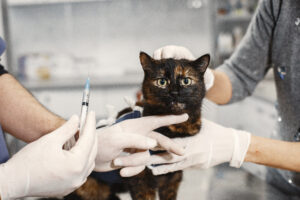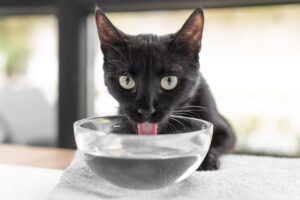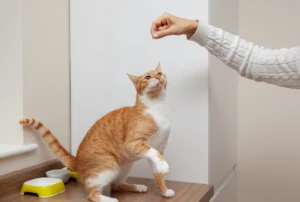Introduction
The tuxedo cat long hair variety is among the most striking and elegant feline companions you can welcome into your home. With their distinctive black and white markings resembling formal attire and their luxurious flowing fur, long-haired tuxedo cats combine sophistication with an undeniable charm that captivates cat lovers worldwide. Despite their popularity, many pet owners make critical mistakes when caring for these distinctive felines, often underestimating the specific needs of a long hair tuxedo cat.
Whether you’re already sharing your home with a fluffy tuxedo cat or considering adopting one, understanding the unique characteristics and requirements of these magnificent creatures is essential for ensuring they live healthy, happy lives. This comprehensive guide will explore the five most shocking mistakes people commonly make with long-haired tuxedo cats and provide expert advice on how to avoid them.
Before diving into these common pitfalls, it’s important to understand that tuxedo cats aren’t actually a specific breed but rather cats with a particular coat pattern. The tuxedo cat breed long hair varieties can appear in many breeds including Maine Coons, Norwegian Forest Cats, and Persian mixes. What makes them “tuxedo” cats is their bi-color pattern with black being predominant and white patches typically appearing on the chest, paws, and sometimes face—creating that distinctive formal “tuxedo” look regardless of their fur length.Long-Haired Tuxedo Cats
Let’s explore the most common mistakes people make when caring for these special felines and how you can provide the best possible care for your long-haired black and white cat companion.

Mistake #1: Underestimating Grooming Requirements
One of the most significant oversights when caring for a long-haired tuxedo cat is failing to establish a proper grooming routine. Many new owners are enchanted by the beautiful long fur tuxedo kitten they bring home, only to become overwhelmed as their pet matures and their coat becomes more demanding.
The Reality of Long Fur Maintenance
The luxurious coat of a long hair tuxedo cat requires consistent attention. Unlike their short-haired counterparts, long-haired tuxedo cats need regular brushing—ideally daily or at minimum 3-4 times per week. Their thick, plush coats are prone to matting, especially in areas where friction occurs such as under the legs, around the collar, and on the belly.
“Long-haired cats, including tuxedo varieties, have a double coat consisting of a soft, dense undercoat and longer guard hairs,” explains Dr. Jennifer Coates, DVM, veterinary advisor with petMD. “This combination creates their beautiful fluffy appearance but also means more potential for tangles and mats.”
Long-Haired Tuxedo Cats
Seasonal Considerations
Many owners of a long-haired black and white cat are surprised to discover the dramatic seasonal shedding these cats experience. During spring and fall, your tuxedo cat long hair companion will typically “blow their coat,” shedding significant amounts of fur as they transition between their winter and summer coats.
During these periods, even more frequent grooming is necessary, sometimes twice daily, to prevent matting and reduce the amount of hair that ends up on your furniture, clothing, and throughout your home.
Proper Grooming Tools
Investing in the right grooming tools is essential for properly maintaining your fluffy tuxedo cat’s coat:
- A stainless steel comb for detecting and working through tangles
- A slicker brush for general coat maintenance
- A de-shedding tool for seasonal heavy shedding periods
- High-quality pet-safe detangling spray for stubborn mats
- Long-Haired Tuxedo Cats
Remember that grooming isn’t just about aesthetics—it’s a health necessity for long-haired tuxedo cats. Regular brushing helps remove dead hair, stimulates blood circulation to the skin, distributes natural oils throughout the coat, and provides an opportunity to check for parasites, skin issues, or abnormalities.
Mistake #2: Ignoring Unique Health Concerns

Another common mistake is failing to recognize that the long fur tuxedo kitten you’ve fallen in love with may have specific health issues related to their distinctive coat type and pattern. While tuxedo markings themselves don’t cause health problems, long-haired cats face certain challenges that short-haired varieties don’t.
Hairballs and Digestive Issues
Long-haired tuxedo cats are particularly prone to hairballs due to the greater amount of fur they ingest during self-grooming. These hairballs can cause serious digestive issues if not addressed properly.
Symptoms of problematic hairballs include:
- Frequent retching or coughing without producing a hairball
- Reduced appetite
- Constipation or diarrhea
- Lethargy
- Long-Haired Tuxedo Cats
“Prevention is key when dealing with hairballs in long-haired cats,” advises Dr. Sarah Wooten, DVM, CVJ. “Regular brushing, specialized hairball-prevention food, and hairball remedies can all help reduce this common problem.”
Skin Conditions
The dense coat of a long hair tuxedo cat can mask skin problems until they become severe. Issues such as flea infestations, fungal infections, or allergic reactions may go unnoticed beneath their thick fur.
Regular grooming sessions should include parting the fur to examine the skin underneath, paying particular attention to:
- Redness or inflammation
- Scabs or sores
- Unusual bumps or growths
- Long-Haired Tuxedo Cats
- Parasites or evidence of their presence
Specific Genetic Considerations
Depending on the underlying breed of your long-haired tuxedo cat, there may be genetic health concerns to be aware of:
- Persian-type tuxedo cats may have breathing issues due to brachycephalic (flat-faced) features
- Maine Coon-type tuxedo cats may be prone to hypertrophic cardiomyopathy (heart disease)
- Norwegian Forest Cat-type tuxedo cats might have higher rates of glycogen storage disease
Understanding the particular breed characteristics of your tuxedo cat with long fur coat is essential for proactive health monitoring. Regular veterinary check-ups are especially important for long-haired cats, regardless of their color pattern.
Mistake #3: Misunderstanding Long-Haired Tuxedo Cat Behavior and Personality Long-Haired Tuxedo Cats
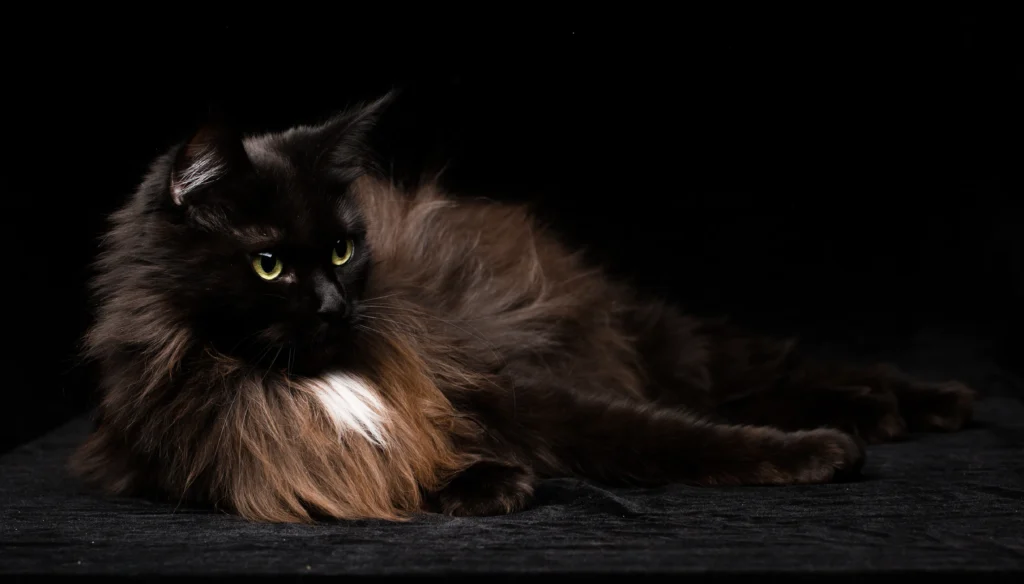
Many people make the mistake of attributing certain personality traits to tuxedo cats based solely on their coloration, without considering how their long hair might influence their behavior and needs. The truth about long-haired tuxedo cat personality traits is more nuanced than many realize.
Temperament Facts and Fiction
There’s a popular belief that tuxedo cats, regardless of hair length, are more intelligent, social, and outgoing than cats with other coat patterns. While many tuxedo cat owners would agree with these observations, science hasn’t conclusively proven a link between coat pattern and personality.
What is true, however, is that long-haired tuxedo cat behavior can be influenced by their physical characteristics. For example:
- Their thick coats can make them more heat-sensitive
- The extra grooming requirements may lead to increased bonding with attentive owners
- Their striking appearance often results in more attention from humans, potentially affecting their social development
- Long-Haired Tuxedo Cats
Dr. Mikel Delgado, Ph.D., certified cat behavior consultant, notes: “While we don’t have evidence that coat color directly determines personality, the way people interact with cats based on their appearance can influence their behavior over time.”
Temperature Regulation and Comfort
A common misconception is that long-haired cats, including tuxedo varieties, are better suited to cold environments and less comfortable in warm climates. While their thick coats do provide excellent insulation in cooler temperatures, long-haired tuxedo cats can adapt to various climate conditions provided they have appropriate care.
In warmer weather, owners should ensure their long-haired black and white cat has:
- Access to cool, shaded areas
- Plenty of fresh water
- Optional cooling pads or elevated beds for better air circulation
- Regular grooming to remove excess undercoat
- Long-Haired Tuxedo Cats
Sensory Experiences
The luxurious fur of a long-haired tuxedo cat significantly affects how they experience physical touch. Some may be more sensitive to petting and handling due to static electricity that can build up in their fur or because of increased nerve endings associated with their hair follicles.
Understanding your individual cat’s preferences for petting and handling is crucial for building trust and a positive relationship. Most long-haired tuxedo cats with proper socialization enjoy:
- Gentle brushing (which also helps with bonding)
- Chin and cheek scratches
- Calm, predictable handling
- Interactive play that respects their personal space
Mistake #4: Providing Inadequate Environmental Enrichment
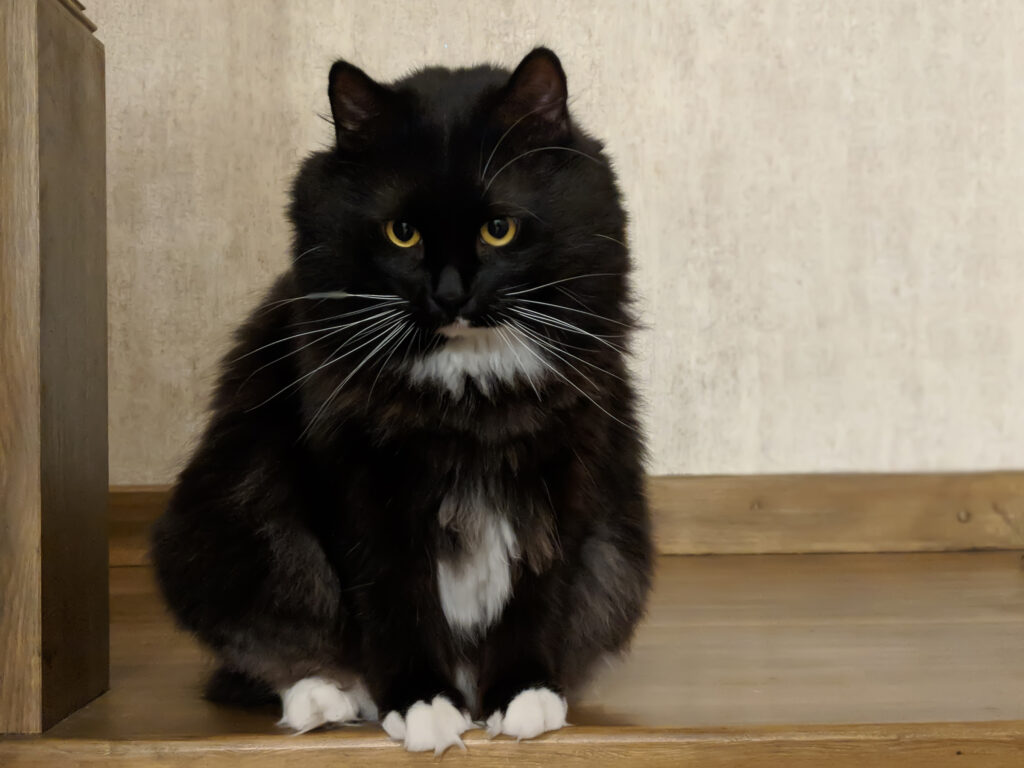
A significant mistake many owners make is failing to create an appropriately enriched environment that addresses the specific needs of a long-haired tuxedo cat. These magnificent creatures require environmental considerations that account for both their physical characteristics and behavioral tendencies.
Climbing and Perching Needs
Tuxedo cats, particularly those with long hair, often display a strong desire to climb and observe their surroundings from elevated positions. Their black and white markings evolved as effective camouflage in dappled light, suggesting ancestral adaptation to forest environments.
To support these natural inclinations, your home should provide:
- Cat trees or shelving that allows for vertical space utilization
- Window perches for outdoor viewing
- Sturdy climbing structures that can support their weight (especially important as some long-haired breeds like Maine Coons can be larger)
“Vertical space is crucially important for cats,” explains Jackson Galaxy, cat behaviorist and host of “My Cat From Hell.” “It allows them to survey their territory and feel secure, which is particularly important for cats with a strong territorial instinct.”
Grooming Stations and Fur Management
Long-haired tuxedo cats benefit from dedicated grooming stations in the home. These areas help contain shed fur and make regular grooming more convenient:
- A washable mat or towel in a quiet corner
- Grooming tools stored nearby
- A comfortable perch at a height that makes grooming easier on your back
Additionally, providing multiple self-grooming options helps your tuxedo cat with long fluffy tail maintain their coat:
- Various textured scratching posts
- Cat brushes that attach to corners for self-rubbing
- Specialized grooming toys that help remove loose fur
Play Considerations
The distinctive markings and fluffy coat of a long-haired tuxedo cat affect how they play and hunt. Their high-contrast coloration may have evolved for better camouflage during dawn and dusk hunting, making them particularly active during these times.
Effective toys for long-haired tuxedo cats include:
- Interactive wand toys that mimic prey movement
- Puzzle feeders that challenge their intelligence
- Toys that don’t easily tangle in their long fur
- Laser pointers (always followed by a physical toy they can “catch”)
Remember that play isn’t just about physical exercise—it’s crucial mental stimulation for your intelligent long-haired tuxedo companion.
Mistake #5: Overlooking Diet and Nutrition Needs
Perhaps the most surprising mistake people make with long-haired tuxedo cats is failing to adjust their diet to account for their specific nutritional requirements. The magnificent coat of a tuxedo cat with long fur requires specific nutritional support to maintain its health and beauty.
Protein Requirements
Long-haired cats, regardless of color pattern, typically need higher protein levels in their diet to support healthy coat growth and maintenance. Their continuous hair growth cycle demands a steady supply of quality protein.
“A cat’s coat is approximately 95% protein,” explains Dr. Justin Shmalberg, DVM and veterinary nutritionist. “Long-haired cats in particular benefit from diets with highly digestible animal proteins to support their continuous coat renewal.”
For optimal coat health in your long-haired tuxedo cat, look for foods that:
- List animal proteins as the first several ingredients
- Contain at least 35-40% protein on a dry matter basis
- Include supplemental taurine, an essential amino acid for cats
Fatty Acid Balance
The lustrous, flowing coat of a long-haired black and white cat breed depends heavily on the right balance of fatty acids in their diet. Omega-3 and Omega-6 fatty acids play crucial roles in maintaining skin health and coat sheen.
Signs your tuxedo cat may need more fatty acids include:
- Dull, brittle fur
- Excessive shedding beyond normal seasonal changes
- Dry, flaky skin
- Slow fur regrowth after shaving
Many premium cat foods formulated for long-haired breeds contain added fatty acids, but you might also consider:
- Fish oil supplements (with veterinary guidance on proper dosage)
- Occasional servings of omega-rich foods like salmon
- Specialized long-hair formulations with added biotin and zinc
Hydration Considerations
Adequate hydration is especially important for long-haired tuxedo cats. Proper hydration supports skin health and helps prevent the formation of troublesome hairballs.
To encourage better hydration:
- Provide multiple fresh water sources throughout your home
- Consider a cat water fountain, as many cats prefer moving water
- Include wet food in their diet (especially important for older cats)
- Add water to dry food if your cat prefers kibble
“Many cats naturally don’t drink enough water,” notes Dr. Gary Richter, MS, DVM. “This can be particularly problematic for long-haired cats who need proper hydration to maintain healthy skin under their thick coats.”
Special Considerations for Long-Haired Tuxedo Kittens
Raising a long fur tuxedo kitten comes with its own set of challenges and considerations. Many first-time owners aren’t prepared for the developmental stages these distinctive kittens go through.
Coat Development
When you first bring home your tuxedo kitten, you might wonder: are tuxedo cats long haired from birth? The answer is both yes and no. While their genetic programming for long hair is present from birth, kittens typically have softer, shorter fur that gradually develops into their adult coat.
Between 3-6 months of age, most long-haired tuxedo kittens begin developing their adult coat, which can be a surprising transition for unprepared owners. During this time:
- Their fur may appear uneven or patchy
- The distinctive black and white pattern may become more pronounced
- The texture changes from kitten softness to more adult characteristics
- Regular, gentle grooming should be introduced to accustom them to the process
Early Socialization
Long hair tuxedo kitten care should include early socialization to grooming procedures. Kittens who are handled regularly and exposed to brushing and combing from an early age typically become adults who tolerate or even enjoy grooming sessions.
Start with:
- Very short, positive grooming experiences
- Soft brushes designed for kittens
- Immediate rewards after grooming
- Gradual introduction to different grooming tools
Nutritional Support for Growth
Growing long-haired tuxedo kittens need excellent nutrition to support both their overall development and their emerging magnificent coat. Kitten-specific formulations provide the higher caloric density and nutrient levels these developing felines require.
Key nutritional elements for long-haired tuxedo kittens include:
- Higher protein levels (35-40%)
- DHA for brain and eye development
- Appropriate calcium-to-phosphorus ratio for bone development
- Essential fatty acids for developing coat health
The Fascinating History and Origin of Long-Haired Tuxedo Cats
Understanding the background of your tuxedo cat long hair companion adds another dimension to your appreciation of these remarkable animals. While tuxedo cats aren’t a specific breed, their distinctive coloration has a fascinating genetic and evolutionary history.
Genetic Foundations
The tuxedo pattern in cats results from a specific expression of the piebald gene, which creates white spotting on a solid-colored background. This gene affects the migration of melanocytes (pigment cells) during embryonic development.
Long hair in cats is determined by a separate genetic factor—a recessive gene that creates longer hair shafts. When a cat inherits the genes for both the tuxedo pattern and long hair, the result is the striking long-haired tuxedo cat that many find so appealing.
Historical Significance
Long hair tuxedo cat facts often include their historical presence in art and literature. Black and white cats with distinctive markings appear in paintings dating back centuries, though distinguishing between short and long-haired varieties in historical depictions can be challenging.
In more recent history, famous long-haired tuxedo cats include:
- Sylvester the Cat (fictional, but inspired by real tuxedo cats)
- Sir Isaac Newton’s beloved cat, who reportedly inspired his work on optics
- Several presidential pets throughout American history
Cultural Impact
Throughout various cultures, black and white cats have held special significance:
- In Japanese folklore, they’re considered good luck
- In Celtic traditions, they were thought to bring prosperity
- In nautical superstition, they were welcome aboard ships as good luck charms
While these cultural associations don’t specifically mention fur length, they show the historical importance of the tuxedo pattern that makes your long-haired tuxedo cat so distinctive.
Common Questions About Long-Haired Tuxedo Cats
Many prospective and current owners have questions about these magnificent felines. Here are answers to some of the most frequently asked questions about tuxedo cat long hair varieties.
Are all tuxedo cats long-haired?
No, tuxedo cats can have either short or long hair. The tuxedo pattern refers only to the black and white coloration that resembles a formal tuxedo, not to the fur length. When people ask “are tuxedo cats long haired?” the answer is that some are, but many have short coats. The long-haired variety is particularly striking due to the contrast between the black and white in their flowing fur.
What breeds commonly display the tuxedo pattern with long hair?
Several cat breeds can exhibit both long hair and the tuxedo pattern, including:
- Maine Coon
- Norwegian Forest Cat
- Persian
- Ragdoll
- Domestic Longhair (mixed breed)
Each brings their own characteristics to the tuxedo pattern, resulting in variations in fur texture, thickness, and overall appearance.
How do I identify a tuxedo cat with long hair?
A true tuxedo cat with long fur coat will display:
- Predominantly black coloration
- White chest (the “shirt front”)
- Often white paws (the “gloves”)
- Sometimes white facial markings
- Fur length exceeding 2 inches
- A fluffy, plume-like tail
Not all black and white long-haired cats are tuxedos—the pattern must resemble formal evening wear with the characteristic “shirt front” on the chest.
Do long-haired tuxedo cats have specific personality traits?
While many owners report that their long-haired tuxedo cat personality includes traits like intelligence, playfulness, and strong bonding with humans, there’s no scientific evidence linking these traits specifically to coat pattern or length. Each cat is an individual with their own unique personality shaped by genetics, environment, and experiences.
How long do long-haired tuxedo cats typically live?
With proper care, long-haired tuxedo cats generally enjoy lifespans of 15-20 years. Their longevity is more influenced by their underlying breed, genetics, diet, exercise, and preventative healthcare than by their coat pattern or length.
Conclusion: Giving Your Long-Haired Tuxedo Cat the Best Life Possible
Avoiding the five shocking mistakes outlined in this article will put you well on your way to providing exceptional care for your tuxedo cat long hair companion. These magnificent felines, with their striking black and white markings and flowing coats, can bring years of joy and companionship when properly cared for.
Remember that your long-haired tuxedo cat is not just a beautiful pet but a complex, sentient being with specific needs related to their physical characteristics. By understanding the unique requirements of these special cats—from grooming and nutrition to environmental enrichment and healthcare—you can ensure your fluffy friend thrives.
Whether you’re currently sharing your home with a long-haired tuxedo cat or considering adding one to your family, taking the time to learn about their distinctive needs is an investment in a healthy, happy relationship. The extra effort required to care for a tuxedo cat with long fluffy tail is amply rewarded by their beauty, companionship, and the special bond that develops between well-cared-for cats and their dedicated owners.
For more comprehensive information about cat care, behavior, and health, explore our other articles at PetsPump. Our guide to cat grooming essentials and understanding cat behavior are particularly relevant for long-haired tuxedo cat owners.
With proper attention to their specific needs, your long-haired black and white cat will flourish, bringing their distinctive elegance and companionship to your home for many years to come.
References and Further Reading
- American Association of Feline Practitioners. (2023). Feline Behavior Guidelines. Retrieved from https://catvets.com/guidelines/practice-guidelines/behavior-guidelines
- Cornell University College of Veterinary Medicine. (2022). Cat Coat Genetics. Retrieved from https://www.vet.cornell.edu/departments-centers-and-institutes/cornell-feline-health-center
- Delgado, M., & Munera, J. (2022). The Indoor Cat Initiative: Environmental and Behavioral Enrichment for Companion Cats. Ohio State University.
- International Cat Care. (2023). Grooming and Coat Care. Retrieved from https://icatcare.org/advice/grooming-and-coat-care/
- Journal of Feline Medicine and Surgery. (2021). Nutritional Requirements for Adult Cats. AAFP/AAHA.
- Stella, J., & Croney, C. (2022). Environmental Enrichment for Indoor Cats. Purdue University College of Veterinary Medicine.
- Veterinary Partner. (2023). Hairball Prevention in Cats. VIN.
- Wooten, S. (2022). A Guide to Long-haired Cat Care. Veterinary Information Network.



